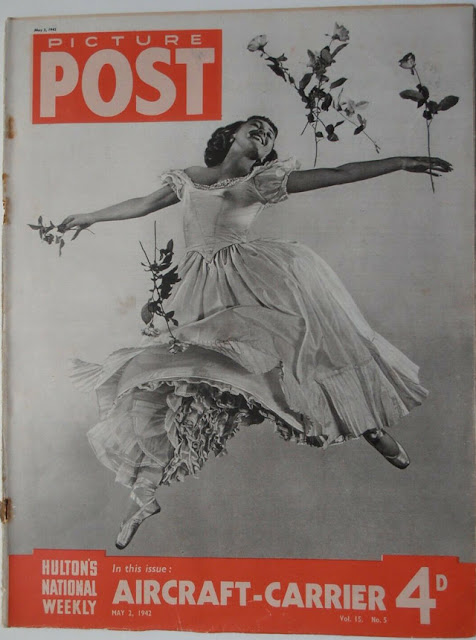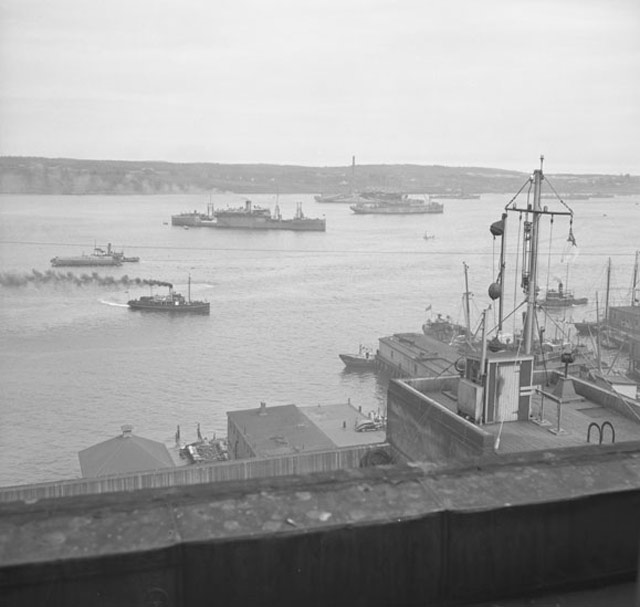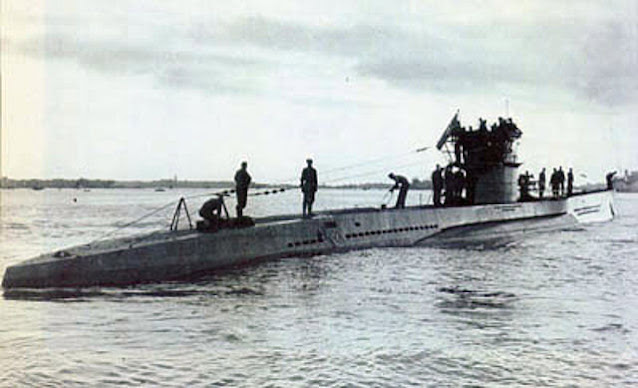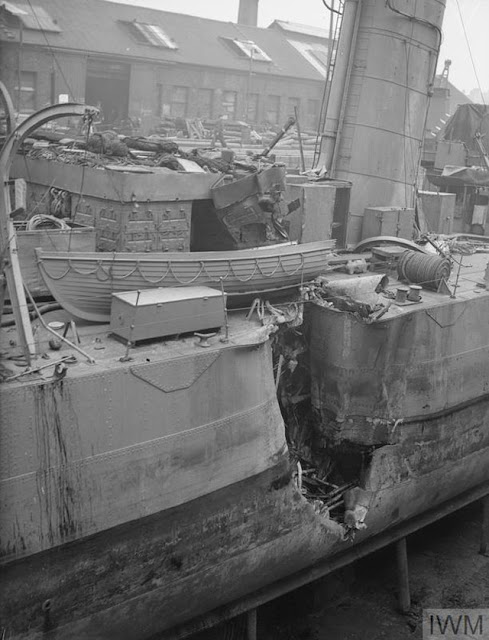Saturday 2 May 1942
 |
| U-boats at the Hel submarine training base in Poland on the Baltic Sea, May 1942. The two U-boats closest to the camera are Type VIIC. |
Battle of the Pacific: The Japanese are on the move in the South West Pacific Area (SWPA) on 2 May 1942. Their Operation Mo has as its first objective the occupation of Tulagi, where the Japanese intend to establish a seaplane base. Coastwatcher Jack Read on Bougainville Island spots large Japanese ships departing the Buka Island area near northern Bougainville, and later coastwatcher D.G. Kennedy on New Georgia (further south on the way to Tulagi) spots the same. Alerted of these sightings on Tulagi, Australian commando commander Captain A. L. Goode and Royal Australian Air Force commander Flight Officer R.B. Peagam order the immediate destruction of their facilities and evacuation of personnel. Flyable PBY-5 Catalina flying boats already have left. The evacuation will be completed by the early hours of 3 May.
The Japanese also have their Carrier Strike Force, led by aircraft carriers Shōkaku and Zuikaku, on the way from Truk. Its commander, Vice Admiral Takeo Takagi, attempts today to deliver eighteen Mitsubishi A6M Zero fighter planes to Rabaul, but poor weather interferes. Ultimately, Takagi is able to deliver the fighters (this is unclear and disputed in the sources), but he must keep trying until the 3rd. The bad weather also prevents Takagi's force from refueling until the 4th. These delays seriously disrupt the entire Japanese timetable for Operation Mo and prevent the Carrier Strike Force from arriving at Tulagi on time to have any effect.
 |
| A portrait of General MacArthur on the Australians Women Weekly, 2 May 1942 |
A separate Japanese force out of New Ireland establishes a seaplane base at Thousand Ships Bay, Santa Isabel Island, to support the projected landings at Tulagi, while the Japanese 3rd Kure Special Landing Force occupies the Florida Islands (Nggela Islands) north of Guadalcanal.
The US Navy has a good idea of the Japanese plans because of radio intercepts. Vice Admiral Frank Jack Fletcher, commander of Task Force 17, has stationed fleet carriers USS Yorktown (TF 17) and Lexington (TF 11) about 300 nautical miles (350 miles, 560 km) northwest of New Caledonia. TF 17 completes its refueling today, but TF 11 takes longer and signals it will not be ready until the 4th. Yorktown aircraft (SBDs (VS 5) and TBDs (VT 5)) spot Japanese submarine I-21 near Nouméa and attack but score no hits. Reporting by radio to Tokyo, the Japanese commander does not indicate that the attacking aircraft are carrier-based, so the nearby US Navy carriers remain undetected.
 |
| Corregidor. |
On Corregidor Island, Philippine Islands, the embattled US garrison (many of the 4th Marine Division) continues to hold out against a vicious around-the-clock pounding from Japanese shore artillery and bombers. Malinta Tunnel is overcrowded - to step outside is to invite death. Potable water is running out, now down to a six-day supply. The US Navy scuttles the river gunboat USS Mindanao off South Harbor. The US Navy is sending submarine USS Starfish to pick up a couple of dozen more lucky people, it is scheduled to arrive on the 3rd.
US Navy submarine USS Trout torpedoes and sinks 5015-ton Japanese freighter Uzan Maru off Shikoku, Japan.
Japanese 10,930-ton seaplane carrier Mizuho, torpedoed off Omaezaki, Japan, by USS Drum on 1 May 1942, sinks about 40 nautical miles (74 km) offshore. There are 472 survivors (31 wounded) and 101 deaths.
 |
| USS Sunfish (Cdr R.W. Peterson) is launched on 2 May 1942 at Mare Island Naval Shipyard, Vallejo, California (US Navy). |
Battle of the Indian Ocean: The Japanese tighten their grip on Mandalay, Burma, on 2 May 1942. Their advance units range far to the west of the former capital. Their occupation of the city and rapid move westward blocks the escape route for part of the 1st Burma Division. It attacks the Japanese 33rd Infantry Division at Monywa, west of Mandalay, in an attempt to rejoin the main British forces north of Mandalay, but fails to make progress.
North of Lashio, the Northern Shan States Battalion, Burma Frontier Force, along with elements of a detachment of the Chin Hills Battalion, continue to block the Japanese advance north toward the regional center at Bhamo. The Allied troops are holding a key bridge across the Shweli River. The bridge has been rigged for detonation, but nobody knows how to set off the charges. The battle for the bridge rages throughout the day while the Japanese troops await reinforcements.
Eastern Front: General Franz Halder, fresh off a week-long leave in Berlin, returns to, as he puts it in his war diary, a "Quiet day along the entire front, except on the Volkhov, where local fighting continues." The Germans have cut off a large Red Army force to the west of the Volkhov River, which now is fighting for its life. Operations along the rest of the front are at a standstill due to the spring thaw ("Rasputitsa") which always peaks around this time of year.
European Air Operations: A pause in major operations by both sides continues today, likely due in part to the weather (the RCAF in England reports "Weather visibility 2000 yards, improving by midday"). The RAF sends 96 bombers of Nos. 3 and 5 Groups on minelaying all along the coast from the German North Sea coast on south to Brittany, France. Two bombers are lost. Another 11 bombers drop leaflet over France.
 |
| Picture Post magazine, 2 May 1942. |
Battle of the Atlantic: The battle in the Barents Sea explodes when German destroyers Z7 "Hermann Schoemann," Z24, and Z25, which attacked convoy QP 11 on 1 May 1942 and sank a freighter, find badly damaged Royal Navy cruiser HMS Edinburgh (Captain H W Faulkner). The German destroyers spot the cruiser at 06:17 about 250 miles east of QP 11. It is moving at only two knots and is escorted by seven ships: destroyers Foresight and Forester, four British minesweepers, and Soviet guard ship Rubin. Despite these poor odds, the German commander Kapitän zur See Alfred Schulze-Hinrichs, flush off his victory against the convoy, decides to attack.
Hinrichs has a problem, however. A snow shower separates his destroyer, Z7, from the two other Kriegsmarine Narvik-class destroyers. Despite this, Hinrichs attacks alone. Edinburgh can only steam in circles, but its guns remain fully operational. It scores a devastating hit on Hinrich's ship that causes it to sink later in the day.
 |
| Light cruiser HMS Edinburgh, with its stern blown off, unloads its crew to another ship before sinking in the Barents Sea, 2 May 1942. |
During the afternoon, the other two German destroyers arrive on the scene. Z25 scores hits on both Forester and Foresight, disabling the former and badly damaging the latter. At 18:52, a German torpedo hits Edinburgh directly opposite its previous damage done to it by U-456. The blows Edinburgh's stern clean off. The German destroyers then withdraw and rescue the crew of Z7, which is still afloat, before scuttling it (other survivors from Z7 are picked up later by U-88). Edinburgh, now in very bad shape, is sunk with a torpedo from Foresight. The action of 2 May 1942 unquestionably is a German naval victory, though the convoys that are the main prize still have suffered minimal losses.
Polish submarine ORP Jastrząb (LtCdr Bolesław Romanowski) is serving with the Royal Navy, but it is hard to distinguish friendly submarines from unfriendly ones under the gray, overcast skies of the Barents Sea. It is in the vicinity of Convoy PQ 15, perhaps loosely escorting it but more likely just on the lookout for German surface ships, when destroyer HNoMS St. Albans and minesweeper Seagull spot it. There are divergent accounts after this point, but the particulars are immutable. The two ships force the submarine to the surface and strafe the deck (killing five men including a British liaison officer and wounding six more). They damage the submarine so badly that it must be scuttled. ORP Jastrząb, incidentally, was former US Navy submarine USS S-25 that was given to the British, and thence the Polish Navy, in November 1941.
 |
| A portrait of Anne Frank in May 1942, shortly before she and her family went into hiding in Amsterdam. |
U-402 (Kptlt. Siegfried Freiherr von Forstner), on its third patrol out of St. Nazaire, torpedoes and sinks 602-ton US Navy patrol yacht USS Cythera (PY-26). This is a former civilian yacht owned by William L. Harkness that served in both World War I and II. There are 69 deaths. The U-boat picks up the only two survivors of the sinking and makes them prisoners of war.
U-66 (KrvKpt. Richard Zapp), on its fifth patrol out of Lorient, torpedoes and sinks 7624-ton Norwegian tanker Sandar southwest of Grenada in the Caribbean. There are three deaths and 37 survivors, who are picked up by US freighter Alcoa Pilot.
 |
| A view of Halifax on 2 May 1942, showing Royal Navy aircraft carrier HMS Illustrious and various US Navy transports (Nova Scotia Archives H.B. Jefferson Nova Scotia Archives 1992-304 / 43.1.4 64). |
Battle of the Mediterranean: U-573, badly damaged on 29 April 1942 by depth charges dropped by an RAF Lockheed Hudson, limps into port at Cartagena, Spain. Since Spain is a neutral country, it can only offer a limited time period before under international law it must intern the submarine. For instance, when German heavy cruiser Admiral Graf Spee docked at Montevideo in December 1939, it was given only 72 hours for repairs.
The Spanish are much more accommodating to the Germans than the Uruguayans had been. They allow three months rather than just three days for repairs to be made before they will take action. Naturally, the British embassy in Madrid protests, but both sides must treat Spain with great sensitivity because it controls access to the Mediterranean - where a major campaign is underway.
Kapitänleutnant Heinrich Heinsohn, however, knows that even three months is insufficient to repair the submarine in Spain. Ultimately, the crew returns to the Reich for further service and the German government sells U-573 to Spain on 2 August 1942 for 1.5 million Reichsmarks. U-573 continues in service there until 1970. U-573 ends her career with on sinking of 5289 tons (Norwegian freighter Hellen on 21 December 1941) and no casualties among her crew - a rarity in the U-boat service.
 |
| U-573 while still in the Kriegsmarine. |
While U-573 gets away, another U-boat does not. Royal Navy destroyers HMS Wishart and Wrestler use depth charges to sink U-74 (Oblt. Karl Friederich), on its eighth patrol out of La Spezia, off Cartagena, Spain. The U-74 is a victim of bad luck, as a Catalina flying boat spots U-573 nearby, and it vectors in the Royal Navy ships that find U-74 instead. U-74 ends its career having sunk 37,144 tons of shipping.
Royal Navy submarine HMS Proteus torpedoes 3682-ton German freighter Otto Leonhardt off Sfax, Tunisia. The ship's captain manages to beach the vessel, but it is a complete write-off.
In Malta, invasion fears are at a peak as heavy bombing raids continue. Delayed-action bombs dropped near Zejtun Church and on houses south of Zejtun-Tarxien road explode, killing 21 civilians and wounding another 30.
 |
| Bomb damage to HMS Wallace, 2 May 1942 © IWM A 9895. |
US Military: Admiral Chester W. Nimitz arrives on Midway Island for an inspection and to present decorations. He departs on the 3rd.
American Homefront: Chestnut stallion Shut Out wins the Kentucky Derby with jockey Wayne D. Wright.
There is a hybrid eclipse of the sun.
Future History: Jacques Rogge is born in Ghent, Belgium. He becomes an orthopedic surgeon and later goes on to become the 8th President of the International Olympic Committee (IOC) from 2001 to 2013. As of this writing, Rogge serves as the Honorary President of the IOC.

No comments:
Post a Comment